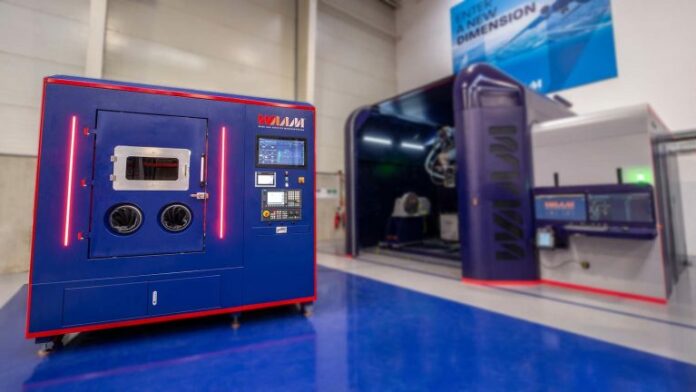WAAM3D, a spin-out company from Cranfield University, has launched a new compact metal 3D printer: MiniWAAM®.
The new 3D printer completes a portfolio that already includes the big RoboWAAM® 3D printer and features the company’s proprietary end-effectors, sensing hardware, and software. According to WAAM3D, it offers a competitively priced manufacturing solution for process development, metallurgical characterisation, production of mechanical test pieces, exploration of new wires, and the testing of new sensors.
With the launch of the company’s new MiniWAAM® platform, the market potential for large format 3D metal printing and repair in aerospace, defence, oil and gas and research communities has just been extended.
Key specifications
Departing from robotic architectures, MiniWAAM® features:
- 3-axis overhead CNC system, plus an additional 500 mm rotational table with 60 kg payload
- A working envelope of 800 mm x 800 mm x 600 mm
- Overall machine dimensions of 2400 mm (width) x 2100 mm (depth) x 2300 mm (height)
- Standalone plug&play installation on shopfloor with full health and safety compliance
Despite its compact size, MiniWAAM® offers the same world-leading hardware capabilities as the bigger RoboWAAM® solution:
- Real time ShapeTechTM – WAAM3D’s own interferometric sensor which reconstructs the 3D profile of the deposited structure, extracting the layer height value all around the component. It gives immediate confidence in the consistency of deposition and in the achievement of key geometrical targets, whilst printing is in progress, eliminating the need for lengthy laser scans or touch-probe quality checks
- Essential WAAM® monitoring (voltage, current, travel speed, wire feed speed)
- Double-point temperature measurement capability – leading the deposition to ensure consistent printing conditions; and trailing the deposition for in-process parameters checks
- Two wire feeders are included. Each of them can be controlled independently in terms of feeding timing and wire feed speeds. With no changes of setup, WAAM® engineers are able to programme the feeding of either the same alloy with two wires to increase deposition rates; or the feeding of different wires to produce functionally graded parts or to perform in-situ alloying.
- Electronic wire positioning for increased process stability
- Process camera for remote melt-pool imaging
- Global shielding for deposition of reactive materials with fully automatic purging, atmosphere maintenance, and evacuation cycles.
Focus on software
The RoboWAAM system is fed and controlled by WAAM3D’s own software suite, built on three fundamental blocks:
- WAAMPlanner® which turns a parts pre-form into executable MiniWAAM® code. It includes planar and non-planar slicing, 2D and 3D sectioning, and layer grouping. It is capable of best-in-class tool-path-planning with dedicated AM approaches and multi-material and multi-process capability.
- WAAMKeys, which populates the tool path plan with process parameters, which are automatically calculated based on geometry and alloy. With advanced thermal compensation modules, it helps achieving the target layer height, regardless of changes in geometrical features.
- WAAMCtrl®, which is an all-encompassing operating system for MiniWAAM®. It incorporates an operator’s dashboard, the component’s digital twin, interactive data navigation, and historical database with complete printing process record (parameter by parameter including all dependent variables such as temperature and shape), seamlessly integrated onto WAAM3D’s hardware and sensors.
Dr Filomeno Martina, CEO of WAAM3D comments: “We are very excited to be launching MiniWAAM®, as its introduction brings the benefits of metal 3D printing to an even wider audience. Thanks to its versatility, MiniWAAM® is ideal for the creation of small to medium-sized metal parts for prototyping and for production and research applications. Its use of 2 wire feeds also makes it of interest for those looking to experiment with composition development and multi-material structure creation. Because of MiniWAAM®’s level of process monitoring, even at such a competitive price point, MiniWAAM® allows research departments to carry out R&D with much higher levels of insights than the less capable ‘home-built’ kits. Moreover, transitioning from MiniWAAM® to the much bigger RoboWAAM® is a seamless process as the fundamental tech elements are exactly the same.”
Remember, you can post free of charge job opportunities in the AM Industry on 3D ADEPT Media or look for a job via our job board. Make sure to follow us on our social networks and subscribe to our weekly newsletter : Facebook, Twitter, LinkedIn & Instagram ! If you want to be featured in the next issue of our digital magazine or if you hear a story that needs to be heard, make sure to send it to contact@3dadept.com.


